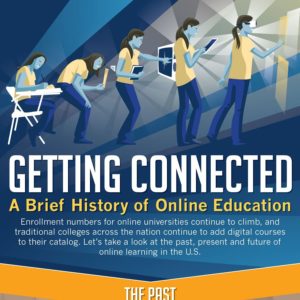Getting Connected: A Brief History of Online Education
Enrollment numbers for online universities continue to climb, and traditional colleges across the nation continue to add digital courses to their catalog. Let’s take a look at the past, present and future of online education in the U.S.
The Past
Here’s a quick look at the past and development of online education in the U.S. (1,2)
1892
The University of Chicago becomes the first school to offer “correspondence” courses.
1922
Pennsylvania State College broadcasts some of its courses over the radio.
1953
The University of Houston offers the first televised college courses.
1965
The University of Wisconsin starts a telephone-based distance learning program for physicians.
1976
Coastline Community College becomes the first “virtual college,” with no campus and all courses broadcast.
1980s
Various online programs begin popping up all over the U.S. due to a higher percentage of personal Internet access.
1989
The University of Phoenix is founded and will soon become one of the most popular online schools across the U.S.
1997
The Interactive Learning Network (ILN) is created and released to multiple schools as the first eLearning platform to be used at universities like Yale, Cornell and the University of Pittsburgh.
Blackboard Inc., a content management system, is founded and still used today at many universities to manage online courses.
2000s
Most major universities begin adding online courses to their curriculum, including some degrees offered entirely online.
2006
Apple introduces iTunes U, offering lectures on a long list of topics available to anyone willing to buy them.
2012
Udacity and EdX, two massive online education websites, open and offer hundreds of university-level MOOCs (Massive Open Online Courses).
The Present
27.1%
Percentage of students who have taken at least one distance learning course (3)
2,659,203
Number of students in 2013 who exclusively took online courses (3)
$107 billion
2015 revenue for the global eLearning market (4)
$8.7 billion
Market value of the mobile learning market, including many self-paced learning apps (4)
8%
Percentage of companies that use MOOCs to train their employees (4)
77%
Percentage of U.S. companies that offer online professional development for their employees (4)
The Future
Higher education may look like this in the future: (5)
No more majors, just goal- and career-oriented learning
No more lectures, all information from class available online for self-paced learning
No more small classrooms, just digital learning, large spaces and open labs
More gamification of learning to make it fun and app-like
Digital field trips using virtual reality
Classrooms that interact with others around the world
Sources:
1. http://www.worldwidelearn.com
2. http://www.saycampuslife.com
3. https://nces.ed.gov
4. http://elearningindustry.com
5. https://www.onlineschoolscenter.com

